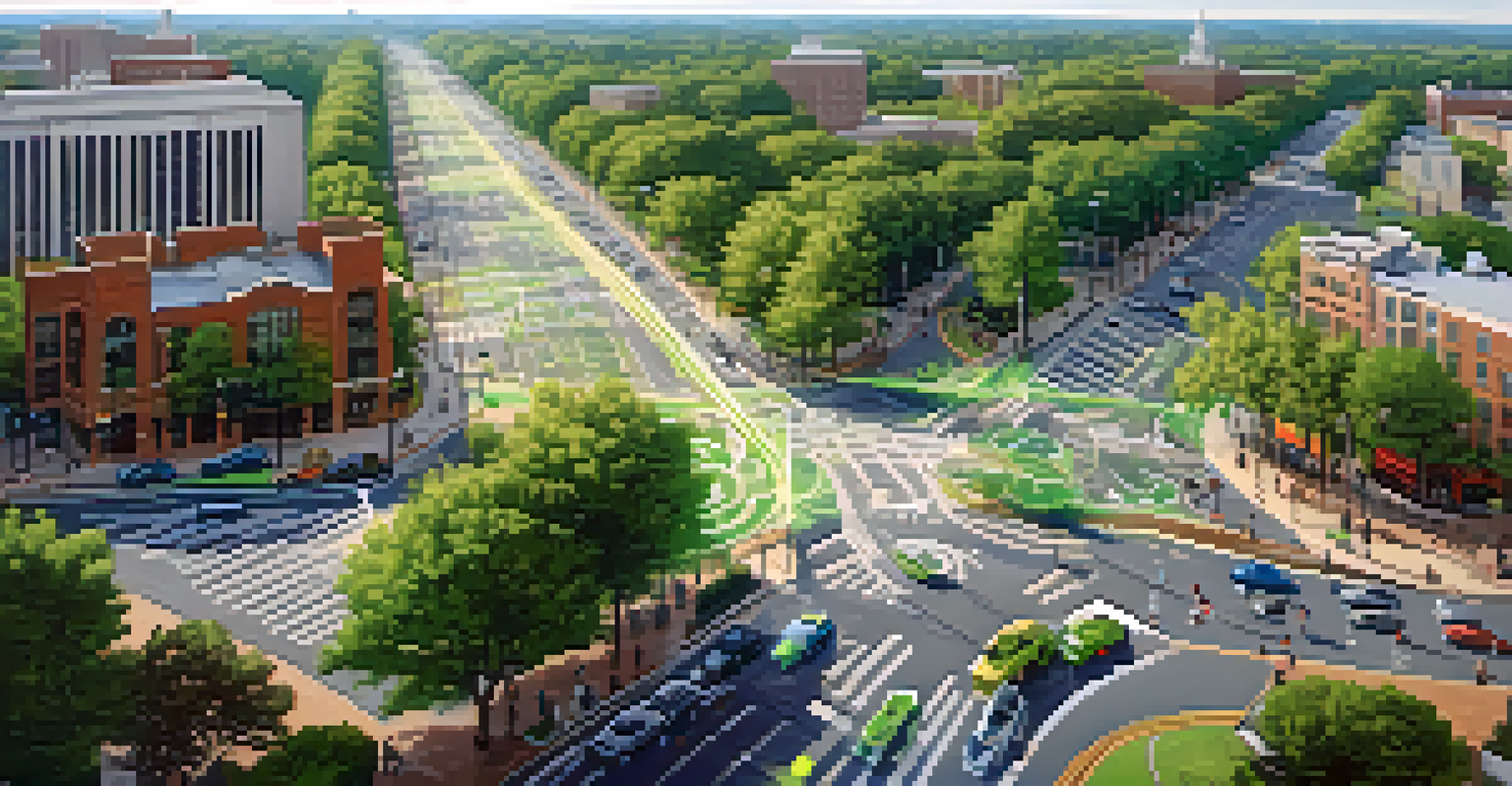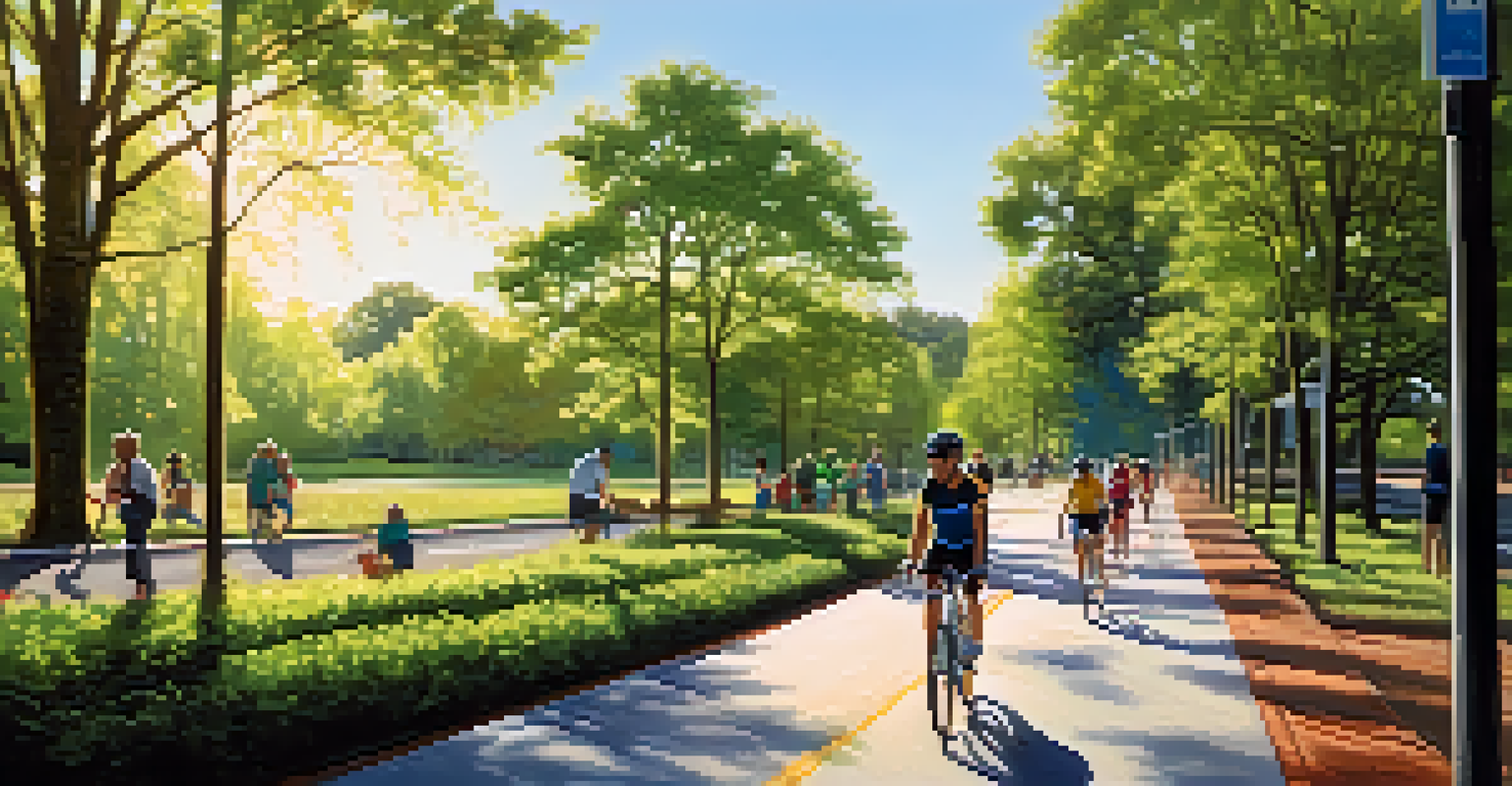The Impact of Technology on Raleigh's Transportation Systems

The Evolution of Raleigh's Transportation Landscape
Raleigh has seen a significant evolution in its transportation systems over the years. From horse-drawn carriages to electric buses, technological advancements have played a crucial role in this transformation. Today, the city boasts a mix of traditional and modern transport solutions, including ride-sharing apps and bike-sharing programs.
The future of transportation is not just about getting from point A to point B; it's about creating a seamless experience that connects people to their communities.
The introduction of smart traffic signals and real-time public transit updates has made getting around Raleigh more efficient. These technologies not only reduce wait times but also help manage traffic flow better. This is particularly important as Raleigh continues to grow and attract new residents and businesses.
As we look ahead, the ongoing integration of technology promises to further enhance Raleigh’s transportation systems. Innovations such as autonomous vehicles and electric scooters are already making waves, paving the way for a more connected and sustainable city.
Smart Traffic Management Systems in Action
One of the most noticeable impacts of technology in Raleigh is the implementation of smart traffic management systems. These systems use sensors and data analytics to monitor traffic in real-time, adjusting signal timings to improve flow and reduce congestion. Imagine being able to navigate through the city without hitting every red light – that’s the goal.

For example, the city has started using adaptive traffic signals that respond to actual traffic conditions rather than a fixed schedule. This means that during rush hour, signals may stay green longer to accommodate heavy traffic, whereas off-peak times can see quicker transitions. Such adjustments significantly enhance the commuting experience.
Tech Enhances Raleigh's Transit System
Innovations like smart traffic signals and real-time updates are improving the efficiency and safety of Raleigh's transportation options.
Moreover, these smart systems also contribute to pedestrian safety. By prioritizing pedestrian signals when foot traffic increases, the city is taking steps to ensure that everyone can navigate Raleigh safely, reflecting a more holistic approach to urban transportation.
The Rise of Ride-Sharing Services in Raleigh
Ride-sharing services like Uber and Lyft have revolutionized how Raleigh residents get around. With just a few taps on a smartphone, users can summon a ride, making transportation more accessible than ever. This convenience has changed the dynamics of urban mobility, especially for those without access to personal vehicles.
Sustainability is no longer a choice; it’s a necessity for our cities to thrive in the future.
Beyond convenience, ride-sharing has also contributed to reducing the number of cars on the road. Many people are opting for rides over owning a car, which not only alleviates parking issues but also lowers emissions in the city. This shift is particularly significant in an area where traffic congestion has been a growing concern.
Additionally, ride-sharing platforms often incorporate features that promote safety and transparency, such as driver ratings and real-time tracking. This enhances trust among users, encouraging even more residents to try these services, and ultimately leading to a more interconnected transport ecosystem.
Public Transit Innovations Enhancing Accessibility
Raleigh's public transit system has also embraced technology to enhance accessibility and efficiency. The introduction of mobile apps allows riders to track bus locations in real-time, making it easier to plan trips. This has been a game-changer for many commuters who rely on public transit for daily travel.
Moreover, the city is investing in electric buses that not only provide a greener option for public transport but also come equipped with modern amenities. These buses often feature Wi-Fi and USB charging ports, making the ride more comfortable and productive for passengers.
Ride-Sharing Reduces Car Dependence
The rise of ride-sharing services is making transportation more accessible, decreasing the number of vehicles on the road, and promoting a cleaner environment.
As the city continues to expand its public transit offerings, the focus remains on making them more user-friendly. Initiatives like improved signage, better route planning, and increased frequency of service are all part of Raleigh's commitment to a more accessible transportation network.
The Role of Biking and Walking in Urban Mobility
Biking and walking are increasingly becoming integral parts of Raleigh’s transportation landscape. With the rise of bike-sharing programs and dedicated bike lanes, the city is promoting more sustainable modes of transport. This not only eases traffic congestion but also encourages a healthier lifestyle among residents.
Local initiatives have focused on creating safe and enjoyable spaces for cyclists and pedestrians. For instance, the expansion of greenways and trails allows for scenic routes that enhance the biking and walking experience. These changes make the city more pedestrian-friendly and visually appealing.
As more residents opt to bike or walk for short trips, it contributes to a reduction in carbon emissions. This shift aligns with Raleigh's broader sustainability goals, creating a cleaner environment while fostering a sense of community among those who choose these active modes of transport.
Autonomous Vehicles: The Future of Raleigh's Transportation
Autonomous vehicles (AVs) are often hailed as the future of urban transportation, and Raleigh is no exception to this trend. With ongoing pilot programs and research initiatives, the city is exploring how AVs can integrate into its existing transportation framework. The potential benefits are significant, from reduced traffic accidents to increased mobility options for those unable to drive.
Imagine a scenario where you can summon a self-driving shuttle to take you to your destination. This could become a reality in Raleigh, enhancing convenience for residents and visitors alike. As technology continues to advance, the idea of a fully autonomous fleet operating in urban settings is becoming less distant.
Sustainability Drives Future Policies
Raleigh's commitment to sustainability is evident in its transportation policies, focusing on electric vehicles and community engagement to shape greener practices.
However, while the promise of AVs is exciting, it also brings challenges. Issues such as infrastructure readiness, regulatory frameworks, and public acceptance need to be addressed. Raleigh’s proactive approach in testing and studying AVs is a step towards ensuring a smooth transition into this next phase of transportation.
Sustainable Practices Shaping Transportation Policies
Sustainability is at the forefront of Raleigh’s transportation planning. The city is actively working to implement policies that encourage greener practices, such as promoting electric vehicles (EVs) and establishing more charging stations. This is a crucial step in reducing the carbon footprint associated with transportation.
In addition to EV initiatives, Raleigh is also exploring alternative fuel sources for its public transit fleet. By investing in hydrogen fuel cell technology and biodiesel options, the city aims to diversify its energy sources while meeting environmental goals. These practices demonstrate a commitment to not only improving transportation but also protecting the planet.

Community engagement is another important aspect of Raleigh's sustainable transportation policies. By involving residents in decision-making processes and seeking their input on future projects, the city ensures that its transportation systems reflect the needs and values of its community.
The Future: A Tech-Driven Transportation Ecosystem
Looking ahead, the future of Raleigh's transportation systems is undoubtedly tech-driven. As cities across the globe adopt innovative solutions, Raleigh is poised to be at the forefront of this transformation. By leveraging technology, the city can create a more efficient, accessible, and sustainable transportation network.
The integration of various transport modes, from public transit to ride-sharing and biking, will be essential in creating a seamless travel experience. Advanced data analytics will play a crucial role in optimizing routes and reducing wait times, making commuting in Raleigh a breeze.
Ultimately, the goal is to foster a transportation ecosystem that prioritizes the needs of its users while promoting environmental sustainability. With ongoing investments in technology and infrastructure, Raleigh is on a promising path towards achieving this vision, ensuring that its transportation systems meet the demands of the future.